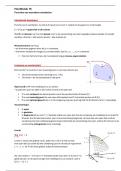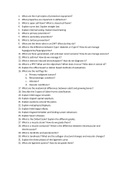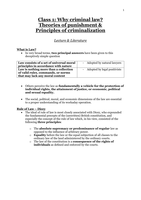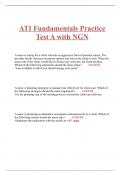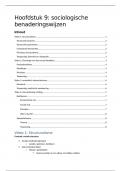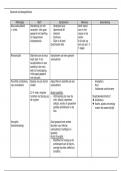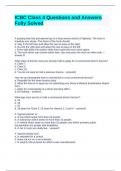Chapter 1 : Introduction hallmarks
1. The development of cancer
• The development of cancer
• Development of cancer
o = slow process
o 1) Start from Normal cells
▪ → cells accumulate mutations pure randomly due to cell division (making mistakes while
copying DNA & sometimes the repair mechanism does not work)
▪ → mutations can be enhanced by a cancer-causing agent: inherited genetic defect, chemical
carcinogens, viral infection, UV light etc
▪ → leads to genetic changes: activation of oncogenes, inactivation of tumor suppressor genes
▪ Opm: in 99% of the tumors, multiple genetic changes are needed for cancer cell
development from a normal cell
o 2) Transformed cells
▪ → metastasis etc.
o Opm: mostly multiple genetic changes are needed for cancer cell development from a normal cell (*)
▪ First mutation in 1 cell giving better proliferation & survival → division into 2 cells with same
first mutation → … → finally 1000 cells with same first mutation → some cells will
accumulate a second mutation (different in other cells: heterogeneity) → which gives more
advantage → …… → cancer development
• Tumor development in the gut
o Duration: 20-40yrs
o Consecutive steps:
▪ 1) Normal epithelium of the gut
▪ 2) losing APC (= tumorsupressor gene) → more proliferation
• = Early adenoma/dysplastic crypt
▪ 3) KRAS mutation → more proliferation
• = Late adenoma
▪ 4) losing TP53 → more proliferation
• = Carcinoma
▪ 5) Other changes → metastasis to spread through the body
• Acute leukemia cells contain 10 to 20 mutations (multiple mutations): targeting
o Notch mutations induce proliferation of cells
o Kinase and signaling protein mutations induce proliferation of cells (rood)
o Changes in epigenetic factors change gene expression
o Ribosomal defects change protein translation
1
, o Transcription factor mutations leading to overexpression etc.
• Proposed model for the development of leukemia
o = the transformation of a bloodcell into a leukemia cell by multiple mutations
o 1) Hematopoietic stem cells
o 2) Committed progenitor cells: myeloid and lymphoid
▪ 1 cell acquire a first mutation and becomes a pre-leukemic cell & multiplies (when the
mutation causes an advantage)
o 3) Differentiated hematopoietic cells & leukemia cells
▪ 1 cell acquire multiple mutations and become a leukemia cell & multiplies (when the
mutation causes an advantage)
▪ Leukemia cells contain:
• 1) major clones = have mutations that are the most effective to transform cells to
leukemia cells (most leukemia cells have these mutations)
• 2) minor clones = have slightly different mutations than major clone (1% of the
leukemia cells have these mutations)
▪ → This leads to Heterogenity of leukemia (similar for solid tumor)
• = same patient has different cells with different mutations
• Diagnosis & treatment of leukemia (similar for solid tumor)
o Diagnosis of leukemia happens through visualizing the major clones (leukemic stage), as the minor
close are more difficult to see
o However for treatment of leukemia it is important to treat both minor & major clones
▪ Reden: when only treating (chemo, drugs) major clones, the major clones are killed → but
the minor clones are less sensitive to the treatment & cause relapse
▪ Solution: use single cell analysis to also identify minor clones & study them
• Same principles apply for solid tumors ipv leukemia
• Accumulation and selection of mutations drive cancer development (solid tumor) (*)
o A solid tumor can have other mutations at the bottom vs the top
▪ → take into account during diagnosis & biopsy
• The evolution of new species = similar to evolution of the tumor: selection (of the fittest) is the key
• 6 hallmarks of cancer (proposed in 2000)
o 1) Sustaining proliferative signaling
o 2) Evading growth suppressors
o 3) Activating invasion and metastasis
o 4) Enabling replicative immortality
o 5) Inducing angiogenesis: new bloodvessel formation for delivering O2 to & removing toxic products
from growing tumor
o 6) Resisting cell death/apoptosis
o → all (most) hallmarks are present during diagnosis of a tumor
▪ Vb: small tumors & leukemia (floating in blood) do not need angiogenesis
o → hallmarks are linked to certain mutations:
▪ Mutation in p53 (inactive) → proliferation
▪ Mutation in Bcl2 (overexpression) → resisting apoptosis
o → order of acquiring the hallmarks can be different from tumor to tumor
• Establishing hallmarks by affecting signaling pathways in cancer cells by mutations
o Vb mutations in growth factors, activating receptors → signaling → proliferation & survival
o Vb: mutations in tyrosine kinase receptors, RAS, PTEN (neg regulator of PI3K), JAK/STAT
o Vb: mutations in Bcl2, bax, fas (all involved in apoptosis)
o Downstream of mutations in cancer cells, you get changes in gene expression (through TF etc)
▪ → used for diagnosis: cells with similar changes in gene expression have similar mutations
• Two additional hallmarks of cancer (proposed in 2011) & two characteristics of cancer
2
, o Emerging hallmarks
▪ 1) Deregulating cellular energetics (metabolism) (both cause & consequence of cancer)
▪ 2) Avoiding immune destruction
o Enabling characteristics
▪ 1) Genome instability and mutation
• → cancer cells have no stable genome, thus keep on accumulating mutations
▪ 2) Tumor-promoting inflammation
• Ten hallmarks of cancer: implications for therapy
• Cancer is a heterogenous tissue
o 1) Cancer cells (CC) with different mutations
o 2) Cancer stem cell (CSC)
o 3) Cancer-Associated fibroblast (CAF)
o 4) Normal cells (stromal cells/stroma)
▪ 1) Endothelial cells (EC)
▪ 2) Pericyte (PC)
▪ 3) Immune, inflammatory cells (ICs) (B & T cells)
o Examples
▪ Hodgkin lymphoma: contains 1% tumor cells (with mutations), 99% normal cells reacting to
the tumor
▪ Leukemia, solid tumors: contains > 99% tumor cells, few normal cells
3
, • Interactions between the cancer cells and the normal cells (an between each other)
o 1) CC produce Hedgehog factor (Hh) & PDGF → stimulating proliferation & production of HGF by
Cancer-associated fibroblast → HGF induces own CC proliferation
o 2) CC produce VEGF → stimulating endothelial cells (for BV formation)
o 3) Tumor-promoting-inflammatory cells produce EGF → stimulating CC
o 4) Tumor-promoting-inflammatory cells produce VEGF → stimulating endothelial cells
o → normal cells can help CC to grow by interaction
o → normal cells can help CC to not be recognized by the IS
o → some growth factors (interaction) are thus target for therapy (using antibodies)
• Interactions between the cancer cells and the normal cells are needed at all stages of cancer development
o 1) Incipient CC & CSC = have few mutations → start already to interact with normal cells
o 2) When CC grow more & more → still interact with normal cells
o 2) When CC move via blood to diff tissue (metastasis) → still interact with normal cells in new tissue
4

